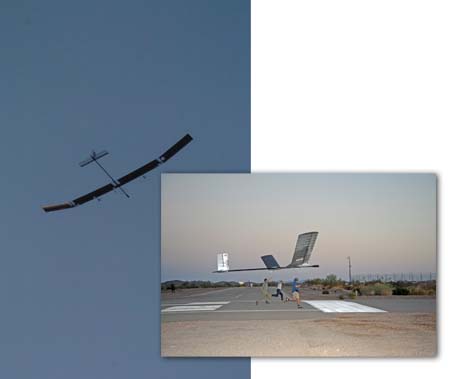Zephyr, a sola r-powered high-altitude, long-endurance unmanned aerial vehicle developed to date under British Ministry of Defence sponsorship, flew for almost three-and-a-half days at the end of July over the Arizona desert, setting an unofficial new endurance mark for unmanned flight. British research and development agency QinetiQ announced Aug. 24 that Zephyr’s flight of 82 hours and 37 minutes from July 28-31 at the Army’s Yuma Proving Ground in Arizona, eclipsed the previous official world record of 30 hours and 24 minutes set in 2001 by Northrop Grumman’s Global Hawk UAV. It also surpassed Zephyr’s own 54-hour flight in 2007. The Yuma flight took place under a joint capability technology demonstration sponsored by the US Department of Defense. The Zephyr reached altitudes of more than 60,000 feet and was flown on autopilot and via satellite communications. It carried a US communications payload for evaluation. Potential applications for Zephyr include communications relay and real-time, persistent battlefield surveillance.
r-powered high-altitude, long-endurance unmanned aerial vehicle developed to date under British Ministry of Defence sponsorship, flew for almost three-and-a-half days at the end of July over the Arizona desert, setting an unofficial new endurance mark for unmanned flight. British research and development agency QinetiQ announced Aug. 24 that Zephyr’s flight of 82 hours and 37 minutes from July 28-31 at the Army’s Yuma Proving Ground in Arizona, eclipsed the previous official world record of 30 hours and 24 minutes set in 2001 by Northrop Grumman’s Global Hawk UAV. It also surpassed Zephyr’s own 54-hour flight in 2007. The Yuma flight took place under a joint capability technology demonstration sponsored by the US Department of Defense. The Zephyr reached altitudes of more than 60,000 feet and was flown on autopilot and via satellite communications. It carried a US communications payload for evaluation. Potential applications for Zephyr include communications relay and real-time, persistent battlefield surveillance.
The rate of building B-21 bombers would speed up if the fiscal 2026 defense budget passes. But it remains unclear how much capacity would be added, and whether the Air Force would simply build the bombers faster, or buy more.
